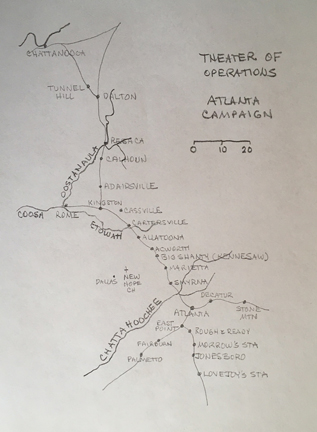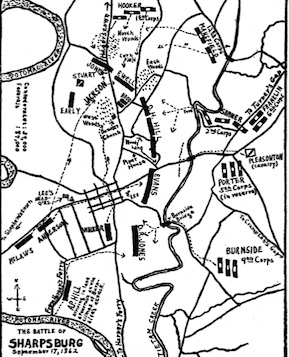Hand-Drawing the “Art” in Cartography
 “Military works are almost universally lacking in adequate maps,” Brig. Gen. Vincent Esposito wrote in his Introduction to The West Point Atlas of American Wars (1959). Boy, was he right. How many times have we thought, while reading an otherwise fine campaign or battle book, that the work needed some good maps. Sometimes, any map at all would do.
“Military works are almost universally lacking in adequate maps,” Brig. Gen. Vincent Esposito wrote in his Introduction to The West Point Atlas of American Wars (1959). Boy, was he right. How many times have we thought, while reading an otherwise fine campaign or battle book, that the work needed some good maps. Sometimes, any map at all would do.
That’s why, when finishing my first book on the Atlanta Campaign book back in 2000, I outlined the need for thirty-two maps. Of course my publisher, Scholarly Resources, apoplected. Maps cost money. Okay, twenty-five, I countered. Nope–too many. We eventually whittled down to fourteen with SRI paying its designated mapmaker, Gary Joiner in Shreveport, up-front. They kindly did so, but against my eventual royalties. “Eventual” is very weaselly—fifteen years after publication of Atlanta Will Fall, I’ve yet to see a royalty check.

But what the hey. I knew what I wanted, and offered to draw a “sketch map” to guide Gary for each one. I learned the concept in Freeman’s R. E. Lee (e.g., “Sketch illustrating how Butler’s Army of the James was ‘bottled’ in Bermuda Neck, May 16, 1864”). Moreover, I knew I could do better than another of my favorite biographers, Allen Tate, who drew his own maps for Stonewall Jackson: The Good Soldier (1928). Check out his cartography of Sharpsburg. It’s so messy, one wonders who won the battle.
Additionally, I am resolved that an author knows when a new map can advance the literature. For example, I wanted to show how General Johnston had his hands full guessing where Sherman would try to cross the Chattahoochee. So I sketched “Crossing-points of the Chattahoochee and situation July 6,” with six ferries downstream from the main railroad ridge, and another seven fords or ferries upstream. No wonder Sherman had such an easy time getting troops across on July 8.
Professor Joiner served well as mapmaker, though I had to chuckle at his “cartography by Gary D. Joiner,” on each of our maps (what about my original sketches!?).
For the Emerging Civil War Series and my recent Atlanta Campaign narrative, I have had the greater pleasure of working with Hal Jesperson, princeps tabularum geographicarum—a true captain of cartography. For A Long and Bloody Task, published last spring, I returned to some of those sketches I drew for my first book, but couldn’t get published. Hal took these and produced mappic marvels. Where else in the literature do you see “Federal Approaches to Dallas May 23-24, 1864?”
And just wait till our second paperback, All the Fighting They Want, comes out this winter. Most Atlanta Campaign histories have a map for the Grant-Presstman line (as I call it), the Confederate fortified perimeter around the city. But what about the entrenched line Hood’s troops dug after July 28, stretching along the Macon & Western R.R. from southwest Atlanta all the way to East Point? You’re not going to find that outside the oeuvres of legendary local historian Wilbur G. Kurtz (who dubbed it Hood’s “railway defense line”). But drawing on my Kurtzian sketch map, Hal has rendered “The Confederate Railway Defense Line Constructed after Ezra Church” for our forthcoming paperback.
Thanks to Hal Jesperson and Chris Mackowski for making all this happen!
————
[EDITOR’S NOTE: To see the final maps Hal Jespersen made from Steve’s meticulously hand-sketched maps, check out A Long and Bloody Task and All the Fighting They Want, both available from Savas Beatie as part of the Emerging Civil War Series.]



Thanks for providing maps in your book at your own expense. Knowing how expensive it is to hire a cartographer I purchased software (Adobe Photoshop and Adobe Illustrator) and prepared my own maps. I prepared all but a couple of maps in my five books. I was fortunate to have two different University Presses accept all the maps I submitted. My last book contained 15 maps. Spread over five books the cost of the software per book was not formidable. .
Joe: The Chancellor of the Exchequer…er… my sweet wife will shoot me for this, but I didn’t care if I saw any royalty shekels. The maps came first.
Glad you agree.
Stephen – I love maps. That’s why I have most of Savas Beatie’s map books. I’ve heard that it is because of cost that we don’t see as many maps as we would like in books. But with the internet, I’m wondering why publishers don’t put additional maps on a website so if desired the reader could follow the campaign or battle there. I realize that by doing that one would have added expenses for the mapmaker but I can’t imagine that it would add that much.
Thanks
Charlie
Charlie: website maps are surely better than zero maps, but I’m a tactile, visual guy. I’m fondest of when the author and publisher collaborate to paste a paper pocket in the back of the book, and tip in a big, folded oversize map (Think Robert C. Black, The Railroads of the Confederacy [1952]). Ah, for those bygone times, and practices!
Stephen – I too prefer them to be in the book but if you say feel that the book should have 50 maps and the publisher only agrees to 20, why not out the other 20 on line so I can print them out? I did a Vicksburg tour wit Ed Bearrs and Terry Winschel back on November 2015 and read Ed’s 3 volume masterpiece in the campaign. However it was difficult to picture a lot of the action because there weren’t sufficient maps. Fortunately the 3 day tour allowed me to visualize the campaign but not everyone has that opportunity.
Love your style. enjoyed this post. It is informative and entertaining
Compliments to the author are always accepted with an avidity exceeding the novelist/barrista accepting tips!
Stephen, your/your collaborator’s maps addeda good deal to Atlanta Must Fall. I maintain that it is the best strategic/operational level study of the campaign, and a pleasure to read!
David: I am undeserving of your kind words, but they are most eagerly accepted. I always feel that a writer’s devoir is to set out to try to make a contribution to the literature. If I have done it with meum opus, I’m more than gratified!
Hello Stephen
When your book, Atlanta Must Fall was published was it published as a hardbound edition with a dustjacket? Or was it just hardbound with no jacket?
Thanks
Don
Don: Scholarly Resources printed hardbounds largely for libraries, which (as you know) discard a dust jacket upon receipt of the book. Ah me, But that’s why I spent so much time with the publisher designing the cover of my paperback
Thanks so much for your support of my work!